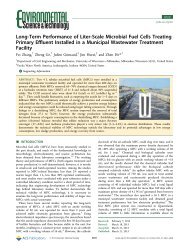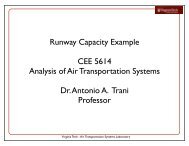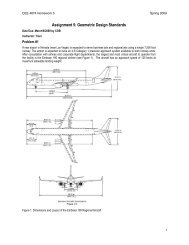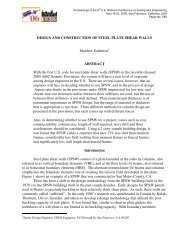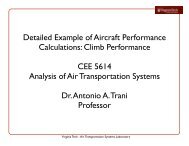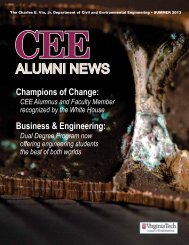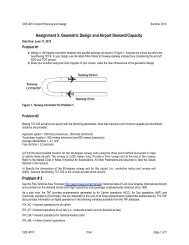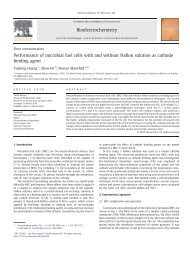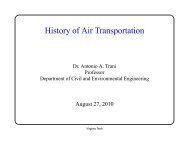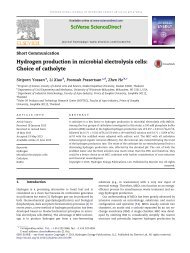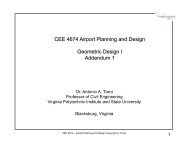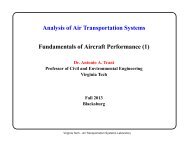Annual Report Year 2009 - Civil and Environmental Engineering
Annual Report Year 2009 - Civil and Environmental Engineering
Annual Report Year 2009 - Civil and Environmental Engineering
- No tags were found...
You also want an ePaper? Increase the reach of your titles
YUMPU automatically turns print PDFs into web optimized ePapers that Google loves.
RESEARCH NEWS<br />
Peter Vikesl<strong>and</strong><br />
<strong>and</strong> Linsey Marr<br />
Nanotechnology impact<br />
Are nanomaterials a risk to environmental health<br />
As researchers around the world<br />
hasten to employ nanotechnology<br />
to improve production methods for<br />
various applications that range from manufacturing<br />
materials to creating new pharmaceutical<br />
drugs, a separate but equally<br />
compelling challenge exists.<br />
History has shown that previous industrial<br />
revolutions, such as those involving<br />
asbestos <strong>and</strong> chloroflurocarbons, have<br />
had some serious environmental impacts.<br />
Might nanotechnology also pose a risk<br />
Linsey Marr <strong>and</strong> Peter Vikesl<strong>and</strong>, two<br />
faculty members in the Via Department of<br />
<strong>Civil</strong> <strong>and</strong> <strong>Environmental</strong> <strong>Engineering</strong>, are<br />
among the ground-breaking investigators<br />
in this field. They are part of the national<br />
Center for the <strong>Environmental</strong> Implications<br />
of NanoTechnology (CEINT), funded by<br />
the National Science Foundation (NSF) in<br />
2008. Along with Michael Hochella, University<br />
Distinguished Professor of Geosciences,<br />
they represent Virginia Tech’s efforts in<br />
a nine-member consortium awarded $14<br />
million over five years, starting in 2008.<br />
Virginia Tech’s portion is $1.75 million.<br />
CEINT is dedicated to elucidating the<br />
relationship between a vast array of nanomaterials<br />
— from natural, to manufactured,<br />
to those produced incidentally by human<br />
activities — <strong>and</strong> their potential environmental<br />
exposure, biological effects, <strong>and</strong><br />
ecological consequences. It will focus on<br />
the fate <strong>and</strong> transport of natural <strong>and</strong> manufactured<br />
nanomaterials in ecosystems.<br />
Headquartered at Duke University,<br />
CEINT is a collaboration between Duke,<br />
Carnegie Mellon University, Howard<br />
University, <strong>and</strong> Virginia Tech as the core<br />
members, as well as investigators from<br />
the University of Kentucky <strong>and</strong> Stanford<br />
University. CEINT academic collaborations<br />
in the U.S. also include on-going activities<br />
coordinated with faculty at Clemson, North<br />
Carolina State, UCLA, <strong>and</strong> Purdue universities.<br />
At Virginia Tech, CEINT is part of the<br />
University’s Institute for Critical Technology<br />
<strong>and</strong> Applied Science (ICTAS).<br />
Scientists <strong>and</strong> engineers at the center<br />
have outlined plans to conduct research<br />
on the possible environmental health<br />
impacts of nanomaterials. The plans include<br />
new approaches, such as creating a<br />
predictive toxicology model based on cell<br />
assays <strong>and</strong> building ecosystems to track<br />
nanoparticles.<br />
Characterization of Airborne Particles<br />
In one of the novel ways Marr is conducting<br />
her tests, she <strong>and</strong> her colleagues<br />
are growing human lung cells <strong>and</strong> placing<br />
them in chambers that leave the lung cell<br />
surface exposed to air. This placement<br />
allows for direct contact of the cells with<br />
aerosolized particles at the air-liquid interface<br />
(ALI). One of Marr’s post-doctoral researchers,<br />
Amara Holder, <strong>and</strong> colleagues<br />
from Berkeley have previously exposed<br />
the cells to particles in diesel exhaust <strong>and</strong><br />
a methane flame. They compared the ALI<br />
exposure to conventional in vitro exposure,<br />
where particles are suspended in a liquid<br />
cell culture medium.<br />
“Our findings showed the ALI exposure<br />
inhalation route is a relevant in vitro approach<br />
<strong>and</strong> is more responsive than the<br />
conventional exposure to particle suspen-<br />
Continued on next page<br />
6 | VIA REPORT | <strong>2009</strong><br />
6 | VIA REPORT | <strong>2009</strong>



